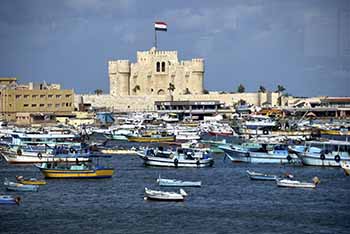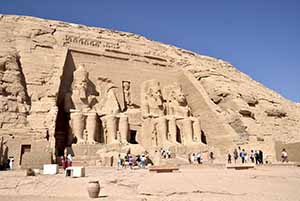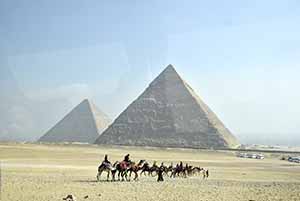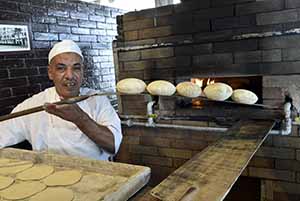This is Part II of Lakeside Senior Reporter Pam Keene’s experiences visiting Egypt and the Nile, during a combination river cruise and land trip taken last November. This installation picks up after a visit to the Valley of the Kings, where King Tut’s tomb is one of more than a dozen and a half where visitors can immerse themselves in the passageways that lead to the burial chambers of some of Egypt’s greatest rulers.
The journey continues upriver south – the Nile is one of only two rivers in the world that flows north – to visit more temples along the Nile on the way to Aswan, Abul Simbel, back to Cairo then north to the modern city of Alexandria.

The Egyptian flag flies over the Citadel of Qaitbay, a 15th century fortress on the Mediterranean coast.
Our river cruise continued after our morning exploration of the Valley of The Kings, our 100-passenger ship the Nefertiti turning to the South to cruise toward Aswan. The Nile’s riverbanks hold the secrets to many ancient temples, including Edfu’s Temple of Horus, the ancient god of war and sky. As one of the country’s best-preserved temples, it is the second-largest in the country.
Taken there by horse and buggy, the trip to the temple along bumpy streets dodging cars, trucks, bicycles and humans was part of the experience. The horses tore down the streets, egged on by their drivers. We arrived to a dusty area with what seemed like hundreds of carts and drivers, many parked under pole barns as they awaited passengers for the return trip.
Thirty-eight massive columns inside began to reflect the Greek and Roman style of architecture as those two civilizations traveled across the Mediterranean to mark their influence known in Egypt. The inside walls are carved with religious scenes. In addition to the many chambers with columns, there’s replica of the wooden boat that was used to take Horus’ statue out of the temple during festivals.
Along the voyage toward Aswan we stopped at several other architectural highlights, including several temples at various times of the day. But our destination of Aswan and the wonder of Abu Simbel was top of mind for us travelers.
The bustling city is famed for its two dams – one built in 1902 and called the Low Dam, and the other constructed between 1960 and 1970, and aptly named the High Dam. Both were built to help regulate flooding; the latter, which created the reservoir called Lake Nasser, generates power and helps increase agricultural production.

Four imposing 70-foot statues on the facade of Abu Simbel Temple depict Ramesses II and Egypt’s three main gods.
When the High Dam was built, the resulting flooding threatened several significant architectural wonders, including the massive Abu Simbel temple built by Ramses II, Egypt’s longest-ruling and by some estimates considered its most powerful king.
UNESCO became involved 60 years ago to spearhead international support to move the mountain and its two temples 658 feet farther inland and 214 feet higher. The project, almost 50 percent funded by Egypt, eventually cost upward of $80 million in 1960 dollars, and took nearly a decade to complete.
Taken apart block by block by teams of archaeologists, engineers and scientists, it has become one of the modern world’s most amazing feats, recreated exactly as it was discovered in the early 1800s.
It was breathtaking on its own but realizing the feat of moving thousands of tons of carved rocks was awe-inspiring. They reconstructed the mountains into which the temples were built, and moved the hand-carved pillars, massive statues and wall paintings.

The great Pyramids of Giza
The next morning we returned by plane to Cairo for a visit the Sphinx and the Giza Pyramids. Not as crowded as the last time I was there, it was enjoyable to walk around the grounds, take photos of camels and horse-drawn carts and the many different cultures who flocked to these ancient marvels. Our visit included camel rides, orchestrated by our trip leaders, against the backdrop of the Pyramids. Off in the distance, the nearly complete Grand Egyptian Museum cut an impressive presence.
Other sights in Cairo included the newer National Museum of Egyptian Civilization, which opened in 2021. More than 50,000 artifacts, from decorated wooden coffins to furniture, statues to jewelry, could have kept us exploring for days. The highlight was the special display of 20 royal mummies of ancient kings and queens. No photos were allowed.
The formal part of our journey was complete and the majority of our travelers returned home. However, about 20 of us took the trip to Alexandria, the second largest city in Egypt and the main port on the Mediterranean in ancient times. Founded by Alexander the Great in 331 BC, with its extensive library and iconic lighthouse, it was the center of civilization.

State-of-the-Art Reading room, Alexandria Library
Today it is an industrial center for natural gas and oil pipelines, but tourists are more interested in the seaside with its many hotels, the new modern library – the largest in the world – and other historic sites.
We visited the Catacombs of Kom El Shoqafa, which combine Roman, Greek and Egyptian cultural influence and were used as burial places from the second to the fourth centuries AD. Our exploration included a climb 25 feet underground to view more wall carvings, multiple chambers and vestibules.
Saving the best for last, we toured the Alexandria Library, opened in 2002 across the highway from the Mediterranean. The main building houses a massive reading room and all the library’s records are available online at no charge. It has space for 8 million books, plus six specialized libraries, four museums, and permanent collections, including ancient manuscripts.

Pitas hot from the woodfired brick oven
Alexandria is the hometown of our trip leader, Marwa, and she took extra time to ensure that we experienced the city from her perspective. For instance, she took us to her favorite ice-cream shop – not like American ice cream, but light and fluffy – and stopped by a streetside vendor who made rather tasty pitas filled with sauteed thin-sliced liver, peppers and onions, a popular Egyptian delicacy. Rick ate two of them; not me, thank-you.
As we left Alexandria and headed back to Cairo for our flight home, it was hard to imagine that the past three weeks were coming to a close. I’m just now getting through the thousands of images I shot with my iPhone and Nikon and reliving the memories of this immersive, amazing bucket-list journey. Although other adventures loom large for 2023, chances are they won’t rival my three weeks in Egypt and all that I experienced.
Photos: by Pamela A. Keene








